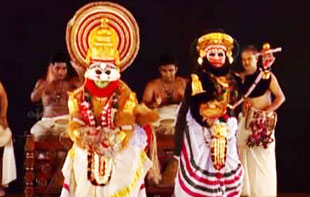Kerala.com Travel Division
WorldViewer Dot Com (India) Pvt. Ltd.
II Floor, G 66, Elders Forum Road
Panampilly Nagar, Cochin, Kerala, India
Pin - 682 036
Mobile: + 91 98460 43403
Mobile: + 91 93886 40364

 Koodiyattam is an art form of Sanskrit theatre traditionally performed in and around Trichur district in the state of Kerala. Performed in the Sanskrit language in Hindu temples, it is believed to be 2000 years old. It is officially recognised by UNESCO as a Masterpiece of the Oral and Intangible Heritage of Humanity. The Koodiyattam performance was confined to the temple precincts of Kerala in specially constructed theatres called koothambalams.
Koodiyattam is an art form of Sanskrit theatre traditionally performed in and around Trichur district in the state of Kerala. Performed in the Sanskrit language in Hindu temples, it is believed to be 2000 years old. It is officially recognised by UNESCO as a Masterpiece of the Oral and Intangible Heritage of Humanity. The Koodiyattam performance was confined to the temple precincts of Kerala in specially constructed theatres called koothambalams.
Traditionally, Koodiyattam has been performed by the chakyar(male) and nangiar(female) community. The name Koodiyattam (meaning "playing together") suggests a combined performance of chakyar and nangyar.The main actor is a Chakyar who performs the ritualistic Koothu and Koodiyattam inside the temple or in the Koothambalam. The female roles are played by the Nangyaramma.There are several aspects to traditional Koodiyattam such as Anguliyanka, Mattavilasa Prahasana, Mantranka, Ezhamanka, etc.
Koodiyattam and Koothu
Chakyar Koothu is another related performing art form from Kerala.It is a kind of mono act and a traditional equivalent of a stand-up comedy act. However, unlike the stand-up comedy, the performer has a wider leeway in that he can heckle the audience. This highly refined art form of narrating stories from Hindu epics (such as the Ramayana and the Mahabharata) and other stories from the Puranas combined with prevailing socio-political events, are ideally performed in temples in connection with festivals by members of the Chakyar community along with Ambalavasi Nambiars. The Chakyar narrates the story based on Sanskrit champu prabandha - a mixture of prose (gadya) and poetry (shloka). The medium used is refined Malayalam along with the original Sanskrit text.
"Koothu" means comic presentation in which facial expressions and gestures alongwith dialogue form the highlight.It was originally performed only in the Koothambalam - a place specially designed to perform Koodiyattam and Chakyar Koothu, inside a Hindu temple and the performer begins with a prayer to the deity of the temple. He then goes on to narrate a verse in Sanskrit before explaining it in the vernacular Malayalam. The narration that follows touches upon various current events and societal factors with great wit and derisive humour.
Koothu was traditionally performed by the Chakyar community. Only two instruments accompany the performance - a mizhavu and a pair of ilathalam. This is different from the Nangiar Koothu, which is performed by women called Nangyarammas who belong to Nambiar caste, and is a more evolved theatre art.
For more details on the cultural capital, log on to trichur.com
For Accommodation - Hotels / Resorts / Homestays in Trichur
WorldViewer Dot Com (India) Pvt. Ltd.
II Floor, G 66, Elders Forum Road
Panampilly Nagar, Cochin, Kerala, India
Pin - 682 036
Mobile: + 91 98460 43403
Mobile: + 91 93886 40364

Kerala Districts : Alappuzha | Ernakulam | Idukki | Kannur | Kollam | Kottayam | Kozhikode | Kasargod | Malappuram | Pathanamthitta |Palakkad | Thiruvananthapuram | Trichur | Wayanad
Other Destinations :Nelliyampathy | Kodanad | Fortkochi | Marari | Kulamavu| Cherai | Kanyakumari | Kumbalangi| Kuttikanam | Ramakkalmedu|Vaikom |